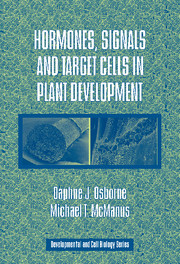Book contents
- Frontmatter
- Contents
- Preface
- 1 Introduction
- 2 Hormones and Signals: Identification and Description of Signalling Molecules
- 3 Cell-to-Cell Signalling: Short and Long Distance
- 4 Population Diversity of Cell Types and Target Identification in Higher Plants
- 5 Flexibility of Cell Types and the Target Cell Status
- 6 Terminally Committed Cell Types and the Target Status
- 7 The Mechanisms of Target Cell Perception and Response to Specific Signals
- 8 Hormone Action and the Relief of Repression
- 9 The Phenomenon of Hormonal Cross-Talk
- References
- Index
1 - Introduction
Published online by Cambridge University Press: 06 August 2009
- Frontmatter
- Contents
- Preface
- 1 Introduction
- 2 Hormones and Signals: Identification and Description of Signalling Molecules
- 3 Cell-to-Cell Signalling: Short and Long Distance
- 4 Population Diversity of Cell Types and Target Identification in Higher Plants
- 5 Flexibility of Cell Types and the Target Cell Status
- 6 Terminally Committed Cell Types and the Target Status
- 7 The Mechanisms of Target Cell Perception and Response to Specific Signals
- 8 Hormone Action and the Relief of Repression
- 9 The Phenomenon of Hormonal Cross-Talk
- References
- Index
Summary
Although it was evident from Darwin's studies of tropisms in plants that informational signals passed from one part of the plant to another, the proof that it was a chemical substance that passed awaited the famous Avena coleoptile experiments of Frits Went (1928). These showed that a molecule (later identified as indole-3-acetic acid [IAA]) was the active agent that was water soluble and would pass across an agar barrier placed between one tissue and another – in his earliest experiments this was between the coleoptile tip (producing IAA) and the IAA-regulated elongating region of the coleoptile below. A tremendous amount of work, both in studying the physiology of this response to IAA, and in identifying the many analogues to IAA, sought the molecular structures required to provide an active molecule. It was from this highly intensive period of plant physiology study that the agricultural revolution of herbicides, defoliants and growth regulators of the 1940s and 1950s was originally generated.
But it was the insect physiologists with their identities of hormone-producing glands and hormone-responding tissues remote from the glands who developed the concepts of target tissues, signalling molecules and receptor sites. Perhaps the most spectacular to record, as an example of the approaches followed later by plant scientists, is the work in the 1930s and 1940s concerning the processes of moulting of larval epidermal skins and of metamorphoses to the adult state (Karlson, 1956).
- Type
- Chapter
- Information
- Publisher: Cambridge University PressPrint publication year: 2005
- 1
- Cited by

